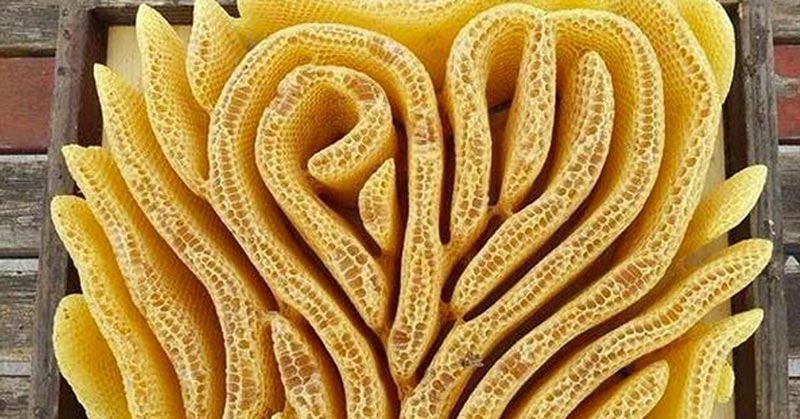You’ll often find apiculturists placing rectangular bordered frames to guide their bees in building hives. Well, there’s a species of bees that would do perfectly fine without those frames.
Normally, some bee species form open colonies in temperate climates where their hives hang off trees, walls, and other surfaces. One such species is the Australian sugarbag (Tetragonula carbonaria). These intelligent insects would form aesthetic spiraling structures without a frame to store their honey. The sugarbag bees are a stingless species that often prefer to make their nest in hollow trunks and tree branches. However, they have no problem nesting on a flat surface if provided by a farmer.
A heart-shaped hive built by a colony of sugarbag bees was captured at Bodiam Castle in Robertsbridge, United Kingdom, and it was quite the ‘bee-utiful’ work of art. Probably not aware of what they were doing, the bees took their time to build columns of honeycomb that curved from top to bottom. They built so many columns that the entire hive looks a lot like a heart-shaped rose with several petals.
How and why do they make spiral hives?

Sugarbag bees are a stingless species, which means they are a lot easier to groom (except for when it’s time for harvest). There are 21 genera of stingless bees, out of which 14 are native to Australia.
What’s even more intriguing about the Bodiam Castle picture is that the bees built the hive on top of a rectangular frame. Other bees would merely dump their combs in irregular patterns and fill the entire space, but these special little buggers don’t settle for anything less than the best. This shows that regardless off the shape and size of the frame, bees of the carboniara species typically build spiral colonies.
According to National Geographic, it’s not yet clear what causes t hese insects to build such complex structures, but it may be to aid easy navigation of the colonies, especially for the queen [2]. Also, spiral architectures seem to be better ventilated than the random sort, and just as you imagine, most bee colonies are poorly ventilated.
The cell building process is quite tasking for stingless bee colonies. According to entomologist Tim Heard, who keeps more than 400 hives in Australia, it’s common to see the worker bees in a large colony working in batches of 80 or more. They build several cells that ascend upward from the base of the curves until every inch of the space is carefully covered. The workers spend about 5 hours building each cell, and they often build a minimum of 5 cells per day. Depending on how many they are and how fast they can work, it’s not uncommon to find 400 completed cells in 50 days.
“What we’re looking at is the advancing front of a stingless bee colony,” Heard says. “In the middle of the spiral, you have to construct cells that move with the change. The cell is almost completely filled with food, and only then will the queen accept that cell for egg-laying.”
Read: A Swarm of Bees Once Followed a Car for 2 Days to Rescue Their Queen
Honey production and colony defense
According to Claus Ramussen, an apiculturist and professor of biology at Aarhus University in Denmark, stingless bees produce honey as good as that of the honeybees, albeit a bit more flavorful. Bees feed on a variety of plants and flowers, and this can affect the flavor of honey they produce. Stingless bees, however, usually stick to the same species of flowers, and they will usually produce stronger-flavored honey.
“The stingless bee honey really wins in terms of having a more floral taste,” Rasmussen says. “For function and taste, stingless bee honey is just as good as honeybee honey.”
According to a review of water homeostasis of bees published in the Journal of Environmental Biology, stingless bees produce 70% concentrated honey [3]. Worker bees consume the water that pools in the nest while the honey is ripening and regurgitate it toward the entrance of the nest. The honey is also said to ferment quicker.
Stingless bees defend themselves by biting. This is a bit more efficient than stinging and dying right after, which is the unfortunate case with honey bees. Honey bees cannot pull their stinger back out and end up rupturing their abdomen, muscles, nerves, and digestive tract.
Stingless bees, however, will bite and inject an irritating formic acid into the enemy’s flesh. The bite is often not lethal, although it may cause pain and swelling. So stingless doesn’t mean harmless, but they make some beautiful hives though, don’t they?
Keep Reading: Want to Help Bees? Leave the Dandelions Alone This Spring

